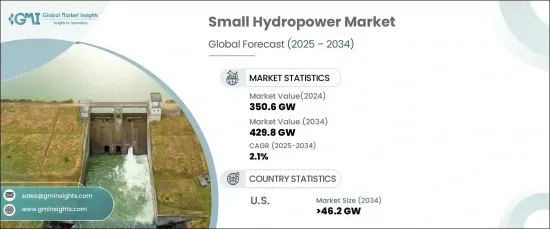
|
市場調査レポート
商品コード
1666565
小水力発電の市場機会、成長促進要因、産業動向分析、2025年~2034年予測Small Hydropower Market Opportunity, Growth Drivers, Industry Trend Analysis, and Forecast 2025 - 2034 |
||||||
カスタマイズ可能
|
|||||||
| 小水力発電の市場機会、成長促進要因、産業動向分析、2025年~2034年予測 |
|
出版日: 2024年12月14日
発行: Global Market Insights Inc.
ページ情報: 英文 80 Pages
納期: 2~3営業日
|
全表示
- 概要
- 目次
世界の小水力発電市場は、2024年までに350.6GWの容量を達成し、2025年から2034年にかけてCAGR2.1%で成長すると予測されています。
この成長は、再生可能エネルギーに対する需要の高まり、持続可能性への注目の高まり、技術の進歩によるところが大きいです。

小水力発電は、100kWから10MWの容量の水力発電システムを指し、遠隔地、小規模公共事業、地域社会にとって利用しやすい選択肢となっています。そのスケーラビリティと汎用性により、これらのシステムは分散型エネルギーソリューションへの世界的移行に大きく貢献しています。これらのシステムは、オフグリッドやマイクログリッドのセットアップをサポートし、信頼できるグリッドアクセスがない地域のニーズに対応します。技術的改善、特にタービン効率とコストの改善は、小水力発電システムの世界の導入可能性をさらに高めています。
米国では、温室効果ガス排出量の削減と再生可能エネルギー源の統合を目指す連邦政府のイニシアティブに後押しされ、小水力発電市場は2034年までに4,620万kWを超えると予想されています。優遇措置、税制優遇、補助金などの有利な政策も、普及を後押ししています。このクリーンなエネルギー源は、より持続可能なエネルギーミックスへの移行という目標に沿った、実用的で信頼性の高いソリューションを提供します。
アジア太平洋では、小水力発電が、遠隔地や十分なサービスを受けていない地域のエネルギー課題に対処するための不可欠な手段として台頭してきています。これらのシステムは、地域の水資源を活用して信頼性の高い電力を供給し、化石燃料への依存を最小限に抑えながら、エネルギー安全保障を向上させます。小水力発電プロジェクトは、国の送電網から独立して運営できるため、孤立した地域社会にとって特に有益です。自給自足を促進し、環境への影響を軽減することで、小水力発電は農村地域の電力をまかなう効果的なソリューションとして支持を集め続けています。
目次
第1章 調査手法と調査範囲
- 市場の定義
- 基本推定と計算
- 予測計算
- データソース
- 一次
- 二次
- 有償
- 公的
第2章 エグゼクティブサマリー
第3章 業界洞察
- 業界エコシステム分析
- 規制状況
- 業界への影響要因
- 成長促進要因
- 業界の潜在的リスク・課題
- 成長可能性分析
- ポーター分析
- 供給企業の交渉力
- 買い手の交渉力
- 新規参入業者の脅威
- 代替品の脅威
- PESTEL分析
第4章 競合情勢
- 戦略ダッシュボード
- イノベーションと持続可能性の展望
第5章 市場規模・予測:地域別、2021年~2034年
- 主要動向
- 北米
- 米国
- カナダ
- メキシコ
- 欧州
- 英国
- ドイツ
- フランス
- スペイン
- イタリア
- ロシア
- トルコ
- ノルウェー
- アジア太平洋
- 中国
- 日本
- インド
- オーストラリア
- 世界のその他の地域
- ブラジル
- イラン
第6章 企業プロファイル
- 24H - Hydro Power
- Agder Energi
- Andritz Hydro
- Derwent Hydroelectric Power
- Fortum
- General Electric
- Lanco Group
- RusHydro
- Siemens
- Statkraft
- Voith
The Global Small Hydropower Market is projected to achieve a capacity of 350.6 GW by 2024 and is expected to grow at a CAGR of 2.1% between 2025 and 2034. This growth is largely driven by rising demand for renewable energy, increased focus on sustainability, and advancements in technology.

Small hydropower refers to hydroelectric systems with a capacity between 100 kW and 10 MW, making them an accessible option for remote areas, small utilities, and local communities. Their scalability and versatility make these systems a key contributor to the global transition towards decentralized energy solutions. These systems support off-grid and microgrid setups, addressing the needs of regions lacking reliable grid access. Technological improvements, particularly in turbine efficiency and cost, further enhance the feasibility of adopting small hydropower systems globally.
In the United States, the small hydropower market is expected to surpass 46.2 GW by 2034, fueled by federal initiatives aimed at reducing greenhouse gas emissions and integrating more renewable energy sources. Favorable policies, such as incentives, tax benefits, and grants, are also encouraging widespread adoption. This cleaner energy source offers a practical and reliable solution, aligning with goals to transition to a more sustainable energy mix.
In the Asia Pacific, small hydropower is emerging as an essential tool to address energy challenges in remote and underserved regions. These systems leverage local water resources to deliver reliable power, minimizing reliance on fossil fuels while improving energy security. The ability of small hydropower projects to operate independently of national grids makes them particularly beneficial for isolated communities. By promoting self-sufficiency and reducing environmental impact, small hydropower continues to gain traction as an effective solution for powering rural areas.
Table of Contents
Chapter 1 Methodology & Scope
- 1.1 Market definitions
- 1.2 Base estimates & calculations
- 1.3 Forecast calculation
- 1.4 Data sources
- 1.4.1 Primary
- 1.4.2 Secondary
- 1.4.2.1 Paid
- 1.4.2.2 Public
Chapter 2 Executive Summary
- 2.1 Industry synopsis, 2021 – 2034
Chapter 3 Industry Insights
- 3.1 Industry ecosystem analysis
- 3.2 Regulatory landscape
- 3.3 Industry impact forces
- 3.3.1 Growth drivers
- 3.3.2 Industry pitfalls & challenges
- 3.4 Growth potential analysis
- 3.5 Porter's Analysis
- 3.5.1 Bargaining power of suppliers
- 3.5.2 Bargaining power of buyers
- 3.5.3 Threat of new entrants
- 3.5.4 Threat of substitutes
- 3.6 PESTEL Analysis
Chapter 4 Competitive landscape, 2024
- 4.1 Strategic dashboard
- 4.2 Innovation & sustainability landscape
Chapter 5 Market Size and Forecast, By Region, 2021 – 2034 (GW)
- 5.1 Key trends
- 5.2 North America
- 5.2.1 U.S.
- 5.2.2 Canada
- 5.2.3 Mexico
- 5.3 Europe
- 5.3.1 UK
- 5.3.2 Germany
- 5.3.3 France
- 5.3.4 Spain
- 5.3.5 Italy
- 5.3.6 Russia
- 5.3.7 Turkey
- 5.3.8 Norway
- 5.4 Asia Pacific
- 5.4.1 China
- 5.4.2 Japan
- 5.4.3 India
- 5.4.4 Australia
- 5.5 Rest of World
- 5.5.1 Brazil
- 5.5.2 Iran
Chapter 6 Company Profiles
- 6.1 24H - Hydro Power
- 6.2 Agder Energi
- 6.3 Andritz Hydro
- 6.4 Derwent Hydroelectric Power
- 6.5 Fortum
- 6.6 General Electric
- 6.7 Lanco Group
- 6.8 RusHydro
- 6.9 Siemens
- 6.10 Statkraft
- 6.11 Voith


